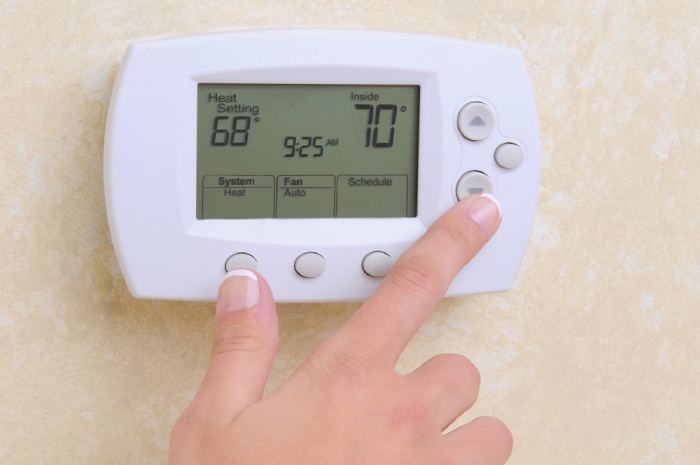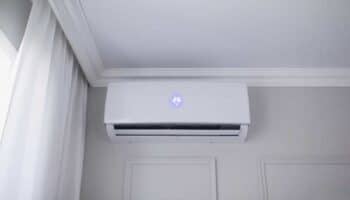We've independently reviewed this article to make sure it's as accurate as we can make it.
To find out more about our article creation and review process, check out our editorial guidelines.
It’s a boiling hot summer day—they seem to be more common—and you’re staring at your thermostat. And you’re thinking about fixing an air conditioner not cooling below 75 or 80 degrees.
You know you have your desired temperature set at 75 but the thermostat is telling you the temperature in your home is way above that. Even though your system has been running for hours.
So what are the possible reasons for an air conditioner failing to reach your set or programmed temperature? Frankly, there are a lot of reasons. Maybe you’ve just been neglectful and haven’t changed your filter.
Maybe it’s something more serious.
Keep reading and I’ll provide a list of possible causes. And solutions that should help you get your home as cool as you want it to be.
Reasons Your Air Conditioner Isn’t Cooling to or Below Your Set Temperature
As mentioned above, there are several reasons. And solutions from the simple to issues you’ll need to hire a pro to deal with.

But first, a few things to consider.
Remember your central air conditioner needs to work harder on hotter days. So if you’ve just turned it on and it’s 100 degrees outside, it could take several hours to cool your house down.
Before panicking, make sure you’ve given your system enough time to do what it’s designed to do.
So let’s get started.
1. A Dirty Air Filter
These things aren’t just added to your system to cost you more money. They’re an integral component, and if you don’t keep up with their maintenance, you could destroy your blower motor. Fixing that will cost far more than a new filter that you can change yourself.

Solution: Check and replace air filters as necessary.
If you want to get any replacement part – or see how much one would cost – click to enter your model number in the search bar below. Our partners at AppliancePartsPros stock almost every part with free guides on how to install them.

2. Weak or Dead Thermostat Batteries
Your thermostat may be the smallest part of your HVAC system, but it could be the most important.
If your thermostat is battery powered, and they are weak—the voltage has dropped—this can impact performance. Even though there’s still enough juice left in the batteries to power your thermostat.
Solution: Replace batteries and monitor room temps to see if the problem is fixed.
Note: If you replace your batteries or check your circuit breakers and you still have the problem, try testing your thermostat. You’ll need a thermometer of some sort for this step.
The International Association of Certified Home Inspectors has a tip for testing inaccurate thermostats. Tape a thermometer to the wall right beside your ‘stat and leave it for 15 minutes. If you have different readings, you may need to recalibrate your thermostat or you may need a new one.
Refer to your manual to see the manufactures instructions on recalibration.
3. Tripped Circuit Breaker
Something may have tripped one of your circuit breakers.
Solution: Head to your home’s electrical panel, which is often located in the basement. If you have all your breakers labeled, just look for the one that would cover the air conditioner.
Note that it’s not always obvious that a breaker has tripped. If you have it labeled and it appears to be fine, you should still do a manual check to make sure it’s fully engaged. If not, engage it. If you don’t have your panel labeled, manually check each breaker to see if they’re all fully engaged.
To manually check, just hold the breaker in your fingers and see if it moves with ease or if it’s locked in place. If it moves, you need to lock it by pulling down on it and then pushing back up until you feel and hear it lock in place.
Note: See the note in #3.
4. Airflow Impeded at the Condenser
Your condenser is located within your compressor, which is the outdoor part of your central air conditioner. The function of the condenser is to release all the hot air that’s been collected from inside.
Guess what happens if it can’t release it? Yep, it’s staying inside, and you house isn’t cooling like it should.
Solution: Head outside and see if any debris has collected around the unit and remove it. Make sure to also access the coils (this should be a clearly marked hatch) and give the condenser coils a clean – this can be done using a gentle spray-down from a garden hose).

If you have any obstructions around it, remove them as well. That could be something you’ve propped up against it or trees/bushes/shrubbery that has grown to close to it.
5. Clogged Drain Line
If your air conditioner keeps stopping itself from running, you may have a clogged drain line. This means the air conditioner isn’t able to drain away the condensate – and most air conditioners will switch off before they start to overflow.
Solution: You have the option of hiring a pro, of course, but if you’re feeling adventurous, you should be able to handle this on your own. You can use this step-by-step walkthrough to unclog your drain line.
6. Refrigerant Leak
Another possible cause for an air conditioner that’s no longer cooling properly is a refrigerant leak.
Check to see if you see any ice or frost buildup anywhere on your refrigerant line. Low pressure in the line due to a leak will cause lower temps in the system. This will eventually freeze your evaporator coil, so detecting a leak early and getting it fixed will save you further expenses.
If you expect you have a leak, you should shut your system down.
Solution: Refrigerant is dangerous and not to handled by anyone not licensed to. So you’ll need to call an HVAC pro to deal with this one.
Note: If you have an older air conditioner that uses R-22 refrigerant you might need a new air conditioner. The phase out of R-22 was announced years ago and as of 2020 it is no longer available—unless some local company has some recycled or reclaimed supplies.
Air Conditioner Maintenance Tips
Did one of the above address the issue you’re having with your central air conditioner?
Would you like to know how to keep your AC in good working condition in order to avoid issues like one that is no longer cooling?
You would? Excellent.
1. Change Your Filters Regularly
This is probably the single most important step you can take to ensure your AC stays in good working order.
Check the recommendation on the filter for the replacement schedule and keep it up to date.
2. Keep Your Coils Clean
This includes both the evaporator and condenser coils, both located in the outdoor unit.
Over time, either can get clogged with dirt and debris which will impact performance, so do an annual check at least. Keep foliage at least 2 feet away and be aware of things like dryer vents, leaves, lawn clippings, and more that can clog up your coils.
3. Check Drain Lines
It’s a good idea to occasionally stick a wire through your drain lines to remove any possible obstructions. Most newer systems will have a cleanout on the trap that is located at the indoor unit. You can use a small brush or snake to break up any slug that develops. A small cap of bleach can help with this.
4. Winter Preparations
Here’s a dirty little industry secret.
In most cases, an air conditioner cover isn’t necessary. Condensers are built to withstand the outdoors. So unless you live somewhere extra salty, like by the sea, you really don’t need to cover up over the winter.
As a matter of fact, the cover is just a cash grab that in many cases will rust your unit before it’s time.
The only thing we do recommend is something just on the top of the ac unit to prevent fall leaves from getting inside of the air conditioner. Over time this build-up can block drainage holes and accelerate rusting on the bottom.
Conclusion
As you can see from above, there are a number of reasons why your air conditioner may not be cooling your home below your set temperature.
Some possible fixes may be as simple as replacing the batteries in your thermostat or checking to see if a circuit breaker has tripped. Others may require an electrician or HVAC professional to diagnose and fix.
As a recap, here is a list of the possible causes:
- A Dirty Air Filter
- Weak or Dead Thermostat Batteries
- Tripped Circuit Breaker
- Airflow Impeded at the Condenser
- Clogged Drain Line
- Refrigerant Leak
The best thing for you to do? Keep your air conditioner well maintained. Maybe you can avoid any future issues.
Thanks for reading! Hopefully, I was able to guide you in the right direction and you’ve fixed the problem.
Why not check out our related posts below? Maybe there’s something else we can help you with.







